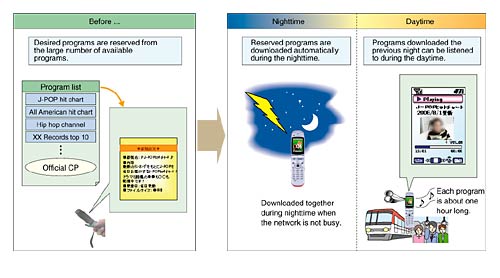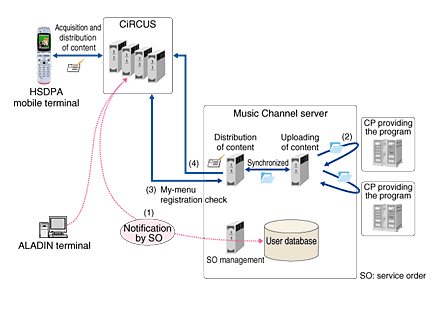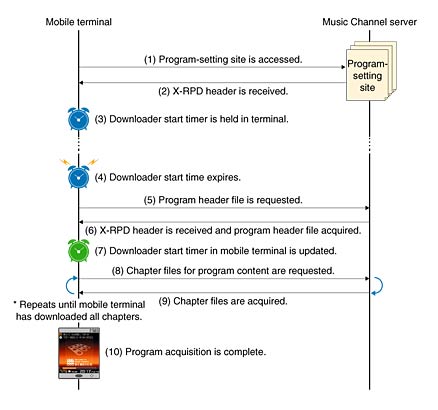 |
|||||||||||||||
|
|
|||||||||||||||
Vol. 5, No. 4, pp. 42–46, Apr. 2007. https://doi.org/10.53829/ntr200704sf6 System Development for an HSDPA Music Channel ServiceAbstractThe HSDPA (high-speed downlink packet access) communications system used with the FOMA network and mobile terminals permits the downloading of large-volume content such as high-quality music and video. This article describes the development of the system that provides NTT DoCoMo's Music ChannelTM service over HSDPA. 1. IntroductionThe introduction of "pake-hodai" (a flat-rate packet service) in June 2004 led to an increase in services providing downloadable content such as radio program content over extended periods of time by using an i-appli (an application based on Java which runs in DoCoMo's mobile terminals) player. This may lead to a shortage of network resources because the use of such services by large numbers of users over a long time increases the network load. The high-speed downlink packet access (HSDPA) service launched in August 2006, which is compatible with the FOMA network and new mobile terminals, enables the downloading of large-volume content such as high-quality music and video, a task that poses considerable difficulties for conventional networks. The Music ChannelTM*1 service was introduced as an application of HSDPA technology. It allows the user to reserve a music program to be automatically downloaded during the night when network traffic is low. This system uses a new distribution method for the trouble-free acquisition of large-volume content and facilitates more efficient use of network resources. This article outlines the functions developed for the Music Channel service and describes the methodology used in its implementation.
2. Service outlineThe Music Channel service is outlined in Fig. 1. To use this service, you need a service contract and an HSDPA mobile terminal that is compatible with the Music Channel. The user reserves a program on the Music Channel service from the website of a contents provider (CP) on the i-Menu (a website available only for DoCoMo's mobile terminals in which many CP's websites certified by DoCoMo are listed). Program reservation, the reserved program, and the downloaded program are managed via the dedicated mobile terminal application. In order to distribute traffic well, the distribution date desired by the CP is set for each day of the week for each program, and the programs are distributed at night on each distribution date. The distributed content may be played at any time on the dedicated player on the mobile terminal.
3. System requirements and configurationBefore the functions of the Music Channel service were developed, the system requirements were investigated taking into consideration the following points. (1) Distribution of network load (2) Content guarantee (3) Simplification of the CP contract In addition to satisfying these requirements, the system configuration used for the service was based on the existing i-channel service, which has very similar requirements (such as the ability to link user information with i-mode and an interface for acquiring content from the CP). The system configuration (Fig. 2) is discussed below. 4. Music Channel server design4.1 Service setupAfter a customer has signed a contract for the Music Channel service, his or her user information is sent to the user database on the Music Channel server via the i-mode gateway called CiRCUS*2 in the form of a service order from the terminal of the customer management system called ALADIN*3 ((1) in Fig. 2).
4.2 Acquisition of content from the CPSince DoCoMo charges for the distribution of content as part of the Music Channel service, we have an obligation to distribute this content without delays. Therefore, we chose a system in which content is acquired from each CP and placed on the server prior to the distribution date to ensure that the operational status of the CP's server does not affect the distribution of content. For each program, the CP prepares a content file, which is composed of a header file containing the program information and multiple music files (hereinafter referred to as chapter files), as well as an MD5 file that indicates the MD5*4 value of the content file. The Music Channel server periodically acquires content from the CP content server via FTP (file transfer protocol)*5 and distributes the most recent files to the mobile terminals on the distribution date. The MD5 value makes it easy to detect whether a file on an external network has been changed. When a file is requested, the system first downloads only the MD5 file and compares it with the previous FTP polling result. If the file has changed, the system downloads the new version. If not, the system can avoid the wasteful downloading of identical program content and use the previously downloaded file instead (2).
4.3 Program reservationIn order to acquire content, the user must reserve a program. Only programs from sites registered on My-Menu may be reserved, so My-Menu is checked whenever a program is reserved or content downloaded (3). 4.4 Traffic distribution methodA feature of this service is off-peak downloading: a user can reserve programs during the day and download them at night. Given the large amount of information to be downloaded, there is a considerable load placed on both the network and system, so the service has a load distribution function. The system responds to a mobile terminal by providing the timing at which the program is to be downloaded in the form of an expanded HTTP header "X-RPD." When a program is reserved, the system responds by sending the computed X-RPD header value so as to distribute the downloading at night (4). The operations performed by the mobile terminal upon receiving the X-RPD header are described in Section 5. 5. Design of the Music Channel mobile terminalThis section describes the three dedicated Music Channel service applications: the Music Channel menu, the downloader, and the player. 5.1 MenuActions available to Music Channel users include program selection, playback, manual reacquisition, and the display of program information. These actions are all selected from the Music Channel menu. 5.2 DownloaderMusic Channel service programs are set by using the i-mode browser and subsequently acquired using the dedicated downloader. Program setting and acquisition are described below (Fig. 3).
5.2.1 Setting programsThe user uses the i-mode browser to access the program-setting site from the Music Channel menu or from a bookmark ((1) in Fig. 3). After accessing the program-setting site, the mobile terminal receives the X-RPD header in the HTTP response from the server (2). This X-RPD header indicates the time until the dedicated downloader starts up (downloader start timer) in order to acquire the set program. When the mobile terminal receives the X-RPD header, the setting of the program at the site is judged to be complete, and the downloader start timer is held in the mobile terminal (3). 5.2.2 Acquiring programsWhen the downloader start time is reached, the mobile terminal automatically starts up the dedicated downloader to acquire the reserved program (4). In the rare event of a failure during program acquisition, when the user notices the failure alert (e.g., the next day), he or she can select reacquisition from the Music Channel menu and manually restart the dedicated downloader. Since download failures are expected to affect only a few users, this daytime downloading will not impose an excessive load on the network. When the dedicated downloader starts up, the program header file is requested (5). The mobile terminal then receives the X-RPD header again with the HTTP response upon acquiring the program header file, with the downloader start timer for the next program distribution then being held in the mobile terminal (6) and (7). After acquiring the program header file, the mobile terminal acquires the chapters in sequence from first to last in accordance with the downloaded information for each chapter file written in the program header file (8) and (9). Program acquisition is successful when the last item of program content has been acquired through the above procedure (10). After the dedicated downloader has started up automatically for program acquisition, if it detects that the mobile terminal is outside the service area, it automatically retries later. If program acquisition is not completed within the stipulated number of retries, the system judges that the program was illegal or that the user forcibly interrupted its acquisition, or that program acquisition failed. In this case, the mobile terminal resets the downloader start timer to a time 24 hours after the failure and waits for an opportunity to automatically acquire the desired program again. 5.3 PlayerMusic Channel service programs are played using an enhanced dedicated player. Programs held in the mobile terminal are selected and played from the Music Channel menu. In the player, the program configuration is analyzed from the header file, and multiple chapters are played consecutively to reproduce a single program. Since a program is composed of multiple chapters, one may start playing back chapters that have been completely received while later chapters are still being acquired. The player limits the playing of programs according to playback restrictions within the header file, the duration of playback, and information on the maximum number of times that a program can be played. The number of times a program can be played is managed in units of chapters to prevent the repeated playing of all chapters in order to listen to a program more than the stipulated number of times. 6. ConclusionThe Music Channel service system was developed as DoCoMo's first service using the features of HSDPA for downloading and enjoying large-volume music content. Efforts to further develop the service and expand the content to accommodate video in addition to existing programs and music are now being investigated. |
|||||||||||||||














